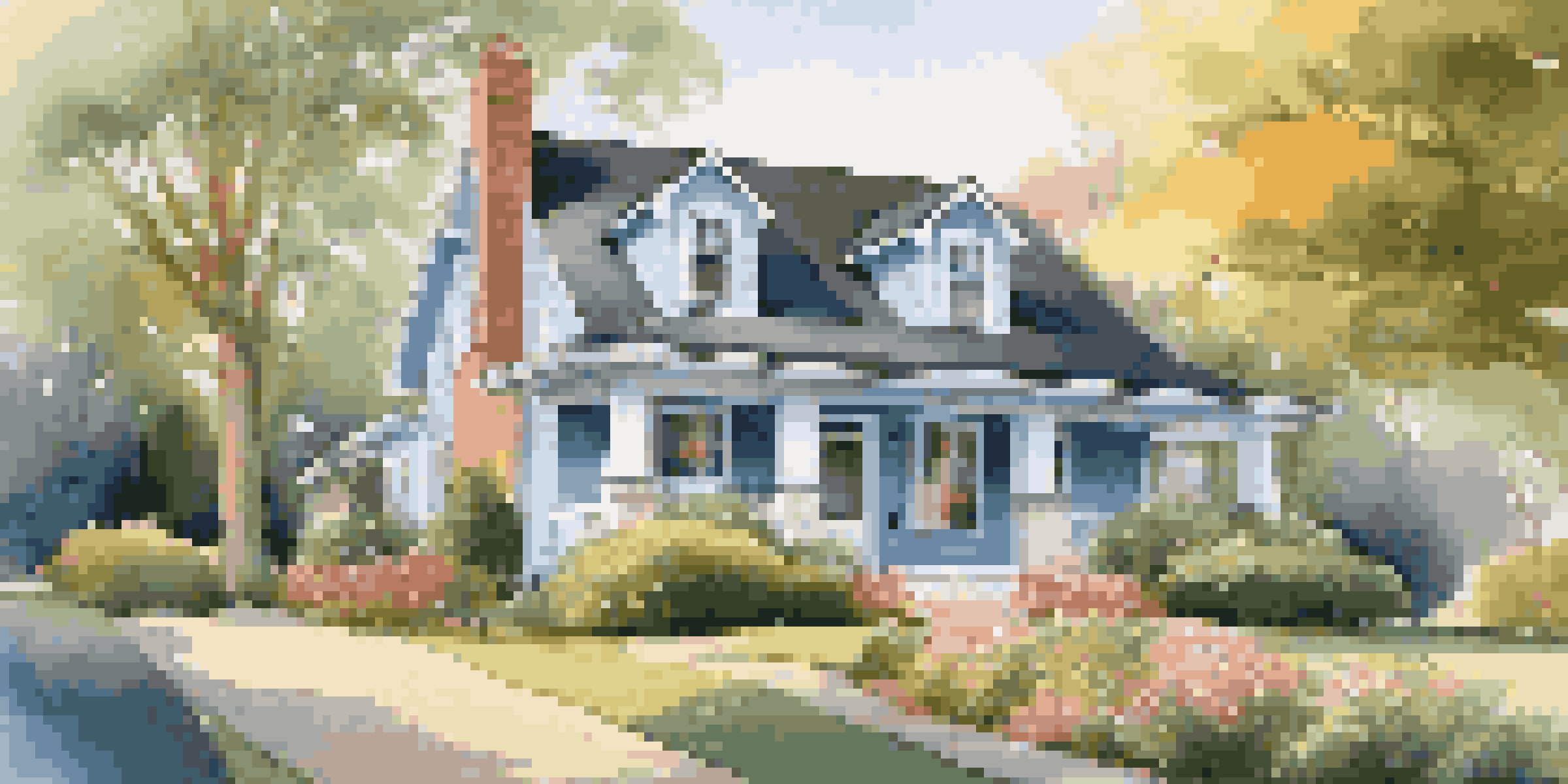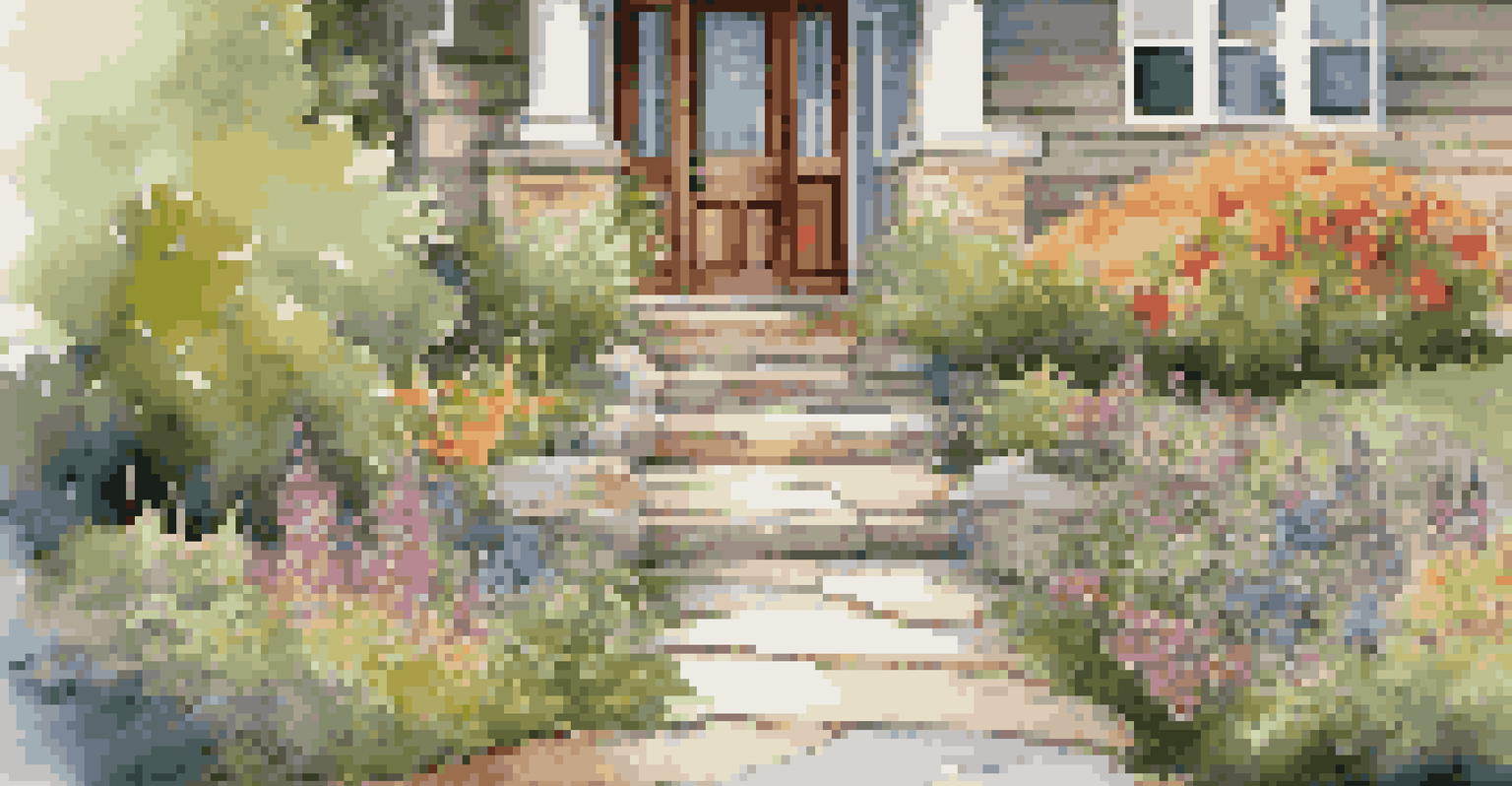The Power of Landscaping: Boosting Curb Appeal Effectively

Understanding Curb Appeal and Its Importance
Curb appeal is the first impression your home makes on visitors and potential buyers. It encompasses everything from your lawn to the entryway, creating a visual narrative about your property. A well-maintained exterior can significantly influence a buyer's perception, often leading to a faster sale at a better price.
The landscape is a reflection of the people who live in it.
Think of curb appeal as the cover of a book; it entices people to want to know more. A charming exterior invites curiosity and interest, while a neglected one can deter even the most enthusiastic house hunter. This initial attraction is crucial, especially in competitive real estate markets where every detail counts.
Investing in curb appeal not only enhances your home's value but also creates a warm, welcoming environment for your family and friends. It’s about pride in ownership and fostering a sense of community. In short, improving your landscape can transform your home from 'just another house' into a cherished haven.
Choosing the Right Plants for Your Landscape
Selecting the right plants is a foundational step in landscaping. Consider factors such as climate, soil type, and sunlight when choosing plants to ensure they thrive in your environment. Native plants are often a great choice, as they require less maintenance and are more resilient to local pests and diseases.

Diversity in your plant selection can create visual interest and balance. Incorporating a mix of perennials, annuals, shrubs, and trees can enhance the overall aesthetic appeal. Additionally, think about seasonal changes; plants that bloom at different times will keep your landscape vibrant year-round.
Curb Appeal Boosts Home Value
Enhancing curb appeal creates a welcoming atmosphere and can lead to faster home sales at better prices.
Don’t overlook the importance of color and texture. A combination of lush greens, vibrant flowers, and varying leaf shapes can create a pleasing contrast that draws the eye. By thoughtfully arranging your plants, you can create a dynamic landscape that complements your home and adds character.
The Role of Hardscaping in Landscaping
Hardscaping refers to the non-plant elements of landscaping, such as patios, walkways, and retaining walls. These features provide structure and functionality, enhancing the overall landscape design. Incorporating hardscaping can also help manage water drainage and reduce soil erosion.
A garden is a friend you can visit any time.
Think of hardscaping as the backbone of your landscape; it creates pathways and outdoor living spaces that encourage relaxation and entertainment. A well-designed patio can become a gathering spot for family and friends, while a welcoming walkway invites guests to explore your garden.
Moreover, hardscaping materials come in various styles and textures, allowing you to personalize your outdoor space. Whether you prefer natural stone, pavers, or concrete, the right hardscaping can elevate your curb appeal and seamlessly blend with your home’s architecture.
Creating Inviting Pathways and Entryways
Pathways and entryways serve as the transition from the outside world to your home. A clear, well-defined path not only guides visitors but also creates a sense of invitation. Consider using materials that complement your home’s style while ensuring safety and accessibility.
Incorporating lighting along pathways can enhance safety and ambiance in the evening hours. Soft, warm lights can create a welcoming atmosphere, highlighting your landscaping features. This touch not only improves functionality but also adds a magical quality to your outdoor spaces.
Choose Plants Wisely
Selecting the right plants based on climate, soil, and sunlight ensures a thriving and visually appealing landscape.
Remember, your entryway is a focal point that sets the tone for your home. Adding decorative elements like planters, benches, or a stylish door can make a lasting impression. A well-designed entryway invites guests in and showcases your commitment to curb appeal.
Maintaining Your Landscape for Long-Term Appeal
Regular maintenance is essential to keep your landscape looking its best. This includes tasks like mowing, pruning, weeding, and watering. Establishing a routine not only enhances your curb appeal but also prolongs the life of your plants and hardscaping features.
Consider seasonal adjustments to your maintenance routine. For example, spring is an excellent time for planting and fertilizing, while fall is ideal for mulching and preparing for winter. By staying proactive, you can ensure your landscape remains vibrant and healthy throughout the year.
Don’t hesitate to seek professional help if needed. Landscape professionals can provide valuable insights and services that elevate your outdoor spaces, especially if you’re looking for specialized care or design. Investing in maintenance can save you time and ensure your landscaping continues to impress.
Utilizing Color and Texture in Your Landscape
Color and texture play vital roles in creating an engaging landscape. By thoughtfully mixing different hues and materials, you can create depth and interest. Consider seasonal colors, such as bright spring blooms or rich autumn foliage, to keep your landscape dynamic throughout the year.
Textures also contribute to the overall feel of your landscape. Combining smooth-leaved plants with rough-textured stones or barks can create a visually appealing contrast. This layering effect can enhance the landscape’s three-dimensional quality, making it more inviting.
Sustainable Landscaping Practices
Incorporating sustainable techniques, like xeriscaping and organic fertilizers, helps maintain an attractive landscape while benefiting the environment.
Don’t be afraid to experiment with bold color choices and unique plant combinations. A vibrant pop of color can draw attention and serve as a focal point in your landscape. Ultimately, the right mix of color and texture can turn your yard into a stunning outdoor retreat.
Incorporating Sustainable Practices in Landscaping
Sustainable landscaping focuses on creating beautiful outdoor spaces while minimizing environmental impact. This can include techniques like xeriscaping, which involves using drought-resistant plants to reduce water usage. By planning your landscape with sustainability in mind, you contribute to a healthier planet.
Using organic fertilizers and pest control methods can further enhance your commitment to sustainability. These practices not only protect your plants but also promote biodiversity, attracting beneficial insects and wildlife to your garden. This creates a balanced ecosystem that thrives naturally.

Additionally, consider implementing water-efficient irrigation systems to conserve resources. Rain barrels or drip irrigation can effectively minimize water waste while maintaining your landscape's health. Sustainable landscaping not only boosts your curb appeal but also sets an example for others in your community.